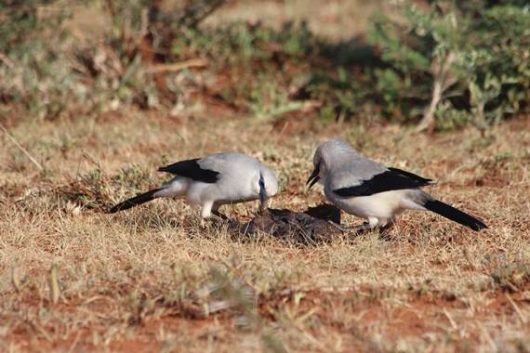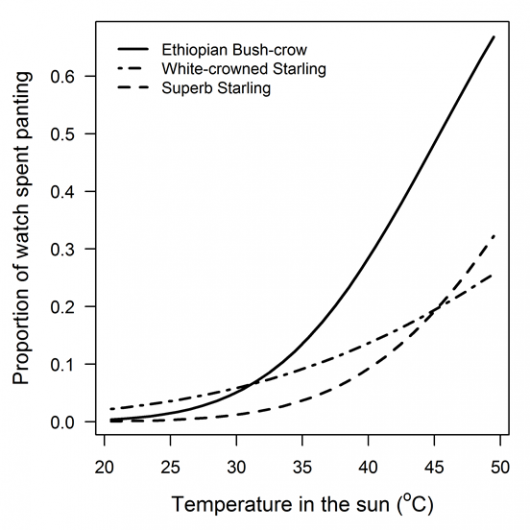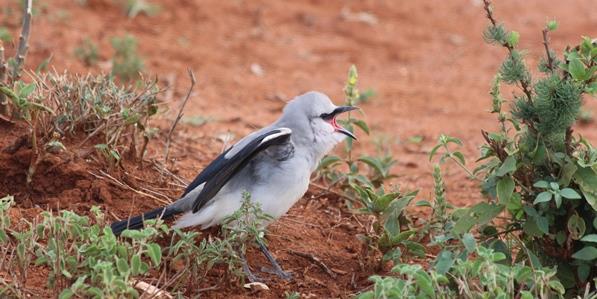What drives the tiny distribution of the enigmatic Ethiopian Bush-crow?
LINKED PAPER
Behavioural thermoregulation and climatic range restriction in the globally threatened Ethiopian Bush-crow Zavattariornis stresemanni. Bladon A.J., Donald P.F., Jones S.E.I., Collar N.J., Deng J., Dadacha G., Abebe Y.D., Green R.E. 2018. IBIS. DOI: 10.1111/ibi.12660. VIEW
The Ethiopian Bush-crow, Zavattariornis stresemanni, is an ornithological enigma. Despite, as its name suggests, being a relative of the crows, jackdaws and magpies common across Eurasia, the Bush-crow is restricted to an area roughly the size of Cornwall. And yet, if you were to visit its native habitat in the Borana rangelands of southern Ethiopia, and see families of noisy “qaaqaa” (ka-ka, in Borana) flying between acacia trees, tending their nests and following local cattle herds, you would be forgiven for assuming that the species is far more abundant than it really is. As Con Benson wrote in 1942, four years after the Bush-crow’s discovery, “I see no reason why this … bird should not occur elsewhere in Eastern Africa”.

Thus the mystery continued for 70 years, until Paul Donald and colleagues published a seminal paper in 2012 (Donald et al. 2012), suggesting that the Bush-crow’s range may be limited by a curious climatic bubble. They found, with preliminary models, that the area of occurrence of the Ethiopian Bush-crow is cooler and drier than surrounding areas, and a model based on this accurately predicted the Bush-crow’s distribution.
But questions remained. The models used only mean climatic variables, yet it is much more likely that a species’ distribution is determined by extreme climatic variables, not climatic averages. And the result provided no clue as to what the mechanism of this curious climatic restriction may be. Why can Bush-crows not survive in the slightly warmer areas just outside their native range?

Let us briefly take a step back. You may be thinking that surely many species are limited by climate. Polar bears don’t occur in the Sahara, nor lions in the Arctic. But the factors which are most important in deciding where a species is, and is not, found are often difficult to determine, for two main reasons. Firstly, it is rare that the same factor is responsible for every single range limit. At the northern, southern, eastern and western edges of a species’ range, factors as diverse as predation, competition, temperature and rainfall may each play a part in restricting distribution. Secondly, even where a climatic variable, say temperature, appears to be implicated, there are different ways this can occur. Most commonly, at least for large vertebrates, the mechanism is indirect; temperature does not affect the species itself, but affects other species (such as particularly important prey) on which it is dependent, and that in turn limits the focal species’ distribution. Occasionally, however, a species may be directly limited by climate, because of its own physiological inability to cope with changes in, say, temperature. This likely occurs in some plants and invertebrates, but rarely in birds and mammals.
Therefore, that the Ethiopian Bush-crow appears to show evidence for a climatically determined limit to its range, on every edge of its small global distribution, makes it every bit the ornithological enigma that Con Benson described in 1942. Dietary limitation can also be ruled out. The Bush-crow has a broad diet, feeding on everything from flying termites to birds’ eggs, so reliance on a single, restricted food type seems unlikely (Jones et al. 2018).
The aim of our study was to try to solve the mystery. Does the result from 2012 stand the test of climate models which use extreme climatic variables rather than averages? Do the Bush-crow’s behavioural responses to daily changes in temperature reveal anything about how it might respond to temperature changes around the edge of its range? And do these results stand up when compared to models fitted to other species with wider geographic ranges, which should show no, or at least a lesser, response to temperature?
To answer these questions, we did two things. Firstly, we re-modelled the Bush-crow’s global range with five measures of climatic extremes: maximum temperature, annual temperature range, temperature seasonality, dry season precipitation and wet season precipitation. For comparison, we also fitted identical models to two similar-sized, ecologically-similar starling species, which occur throughout the Bush-crow’s range as well as more widely outside of it. This wider range suggests that they should not be limited by the same temperature isotherm as the Bush-crow. Secondly, we used behavioural studies to investigate how the Bush-crow, and the two starlings, respond to daily temperature changes. We monitored time spent in the sun and shade, thermoregulatory behaviour, and food intake rate of the three species. If the Bush-crow’s range is truly limited by an inability to cope with high temperatures, then it should show behavioural changes at lower ambient temperatures than either of the starlings, which we hypothesise are not thermally-limited.

The results could not have been clearer. The Ethiopian Bush-crow showed every response we predicted: a sharp decline in probability of occurrence in response to maximum temperature, which was the most important variable in the distribution models; more time spent in the shade and thermoregulating at higher temperatures; and a decline in food intake rate as temperatures rose. Meanwhile, the two starlings showed no effect of temperature on their distributions, spent less time in the shade and less time thermoregulating than the Bush-crow at any given temperature, and suffered no ill-effects of rising temperatures on their food intake rates.

So the 70-year old mystery of the Ethiopian Bush-crow’s curious distribution is solved. But what the physiological mechanism underpinning its thermal intolerance is, and how the species might fare in a warming climate, remain to be investigated.
References
Bladon, A.J., Jones, S.E.I., Collar, N.J., Dellelegn, Y., Donald, P.F., Gedeon, K., Green, R.E., Spottiswoode, C.N., Töpfer, T. & Wondafrash, M. 2016. Further notes on the natural history of the Ethiopian Bush-crow Zavattariornis stresemanni. Bulletin of the African Bird Club 23(1): 27-45. VIEW
Donald, P.F., Gedeon, K., Collar, N.J., Spottiswoode, C.N., Wondafrash, M. & Buchanan, G. 2012. The restricted range of the Ethiopian Bush-crow Zavattariornis stresemanni is a consequence of high reliance on modified habitats within narrow climatic limits. Journal of Ornithology 153(4): 1031-1044. VIEW
Gedeon, K. 2006. Observations on the biology of the Ethiopian Bush-crow Zavattariornis stresemanni. Bulletin of the African Bird Club 13(2): 178-188. VIEW
Jones, S.E.I., Bladon, A.J., Collar, N.J., Dadacha, G., Denge, J. & Donald, P.F. 2018. Varied diet and opportunistic foraging in the Ethiopian Bush-crow Zavattariornis stresemanni: an Endangered generalist. Ostrich 89(1): 41–46. VIEW
Image credits
Featured image: Ethiopian Bush-crow, Zavattariornis stresemanni © Andrew Bladon
Blog posts express the views of the individual author(s) and not those of the BOU.
If you want to write about your research in #theBOUblog, then please see here.





